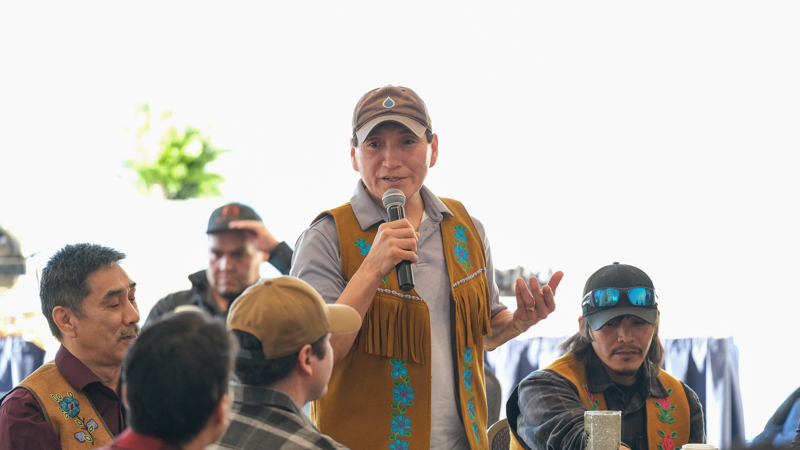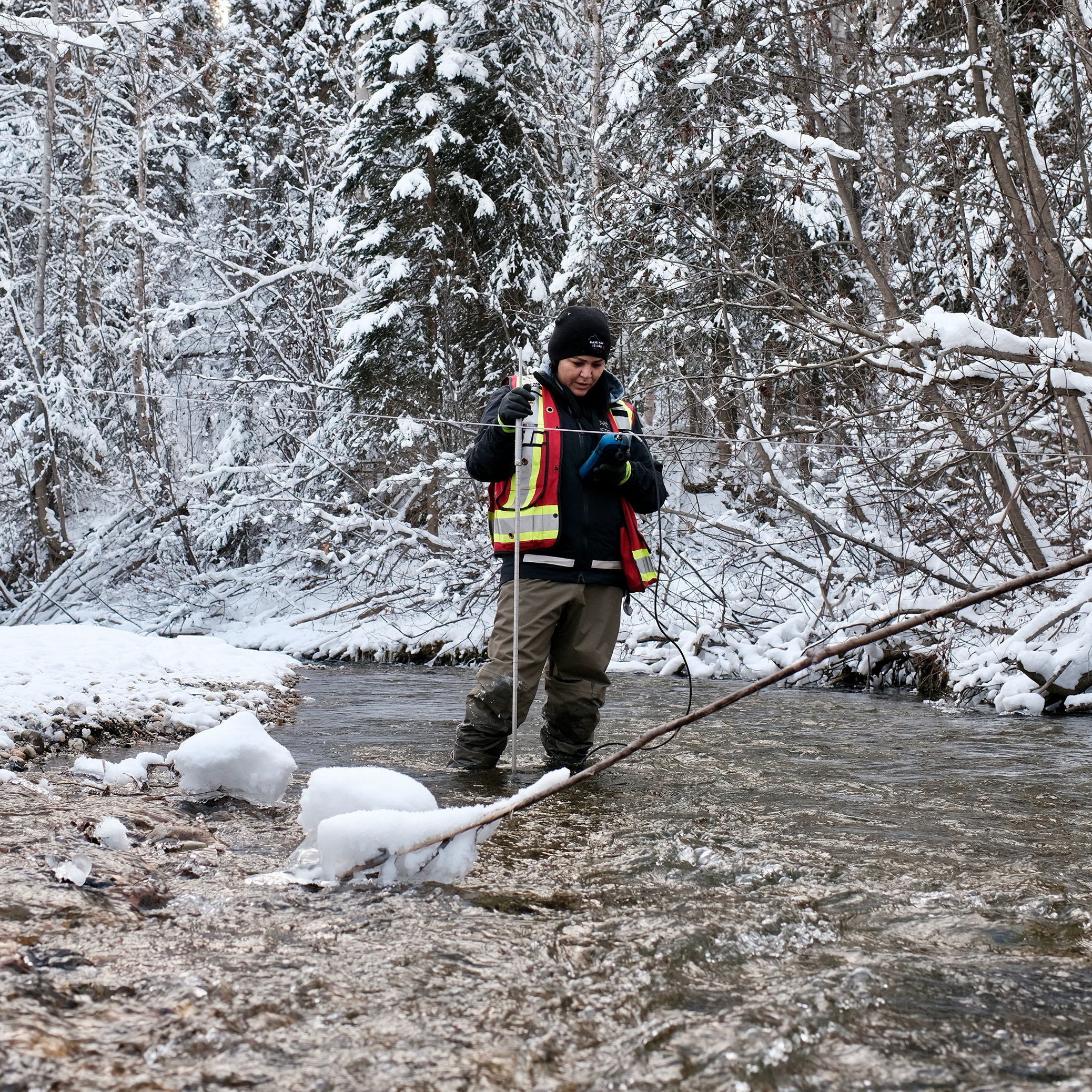It’s the last week of February in Sǫ̀mba K’è, on Chief Drygeese Territory, Treaty 8 land, homelands of the Yellowknives Dene, where 30 Indigenous guardians and allies from three northern territories have gathered to share their knowledge.
In what has been briefly and colonially known as Yellowknife, the outside temperature is hovering around -25, but the power of the late winter sun can be felt through the conference-room windows. There are thirty-odd Indigenous guardians and allies from across the three northern territories seated around tables in groups of six or eight. The facilitator asks the participants to discuss the following questions in small groups of six to eight: What are the goals of your program? What does a typical day look like for you? Are you working on any big projects?
While Indigenous guardianship looks different across different cultures and landscapes, there are commonalities between programs. As the eyes and ears of Indigenous Nations in their territories, guardians are responsible for environmental monitoring, caring for cultural sites, managing protected areas, and interacting with homeland guests. They also play an important role in land-based knowledge transfers and practices with younger generations. The Indigenous Leadership Initiative, a national advocacy organization that has been critical to securing federal support for Indigenous-led stewardship, estimates there are more than 110 guardians programs across Canada.

Photo: Amos Scott
This is the first in-person gathering of the Northern Indigenous Stewardship Circle, one of approximately ten northern projects on MakeWay’s Shared Platform. Designed and led by Indigenous northerners, the Stewardship Circle was established in 2021 to build connections and facilitate information-sharing amongst Indigenous guardians and environmental stewardship programs across northern Canada.
Building the Circle
MakeWay began bringing northern guardians together in 2018. As Steve Ellis, Northern Program Lead explains, guardians programs touch on all four of MakeWay’s priority areas in the North: Indigenous cultural resurgence, land and water stewardship, sustainable livelihoods, and northern leadership. “Guardians are actively going out and stewarding their territory. How they take care of their land is part of their culture, and the knowledge of how to do that work is embedded in language. A lot of young people, young leaders come up through guardians programs. And they are creating sustainable jobs that fit with people’s culture and community aspirations.”
Five years ago, most programs were early stage, and many of them had questions about the same things: human resources, policies and procedures, safety protocols, communications, training. “We recognized that everybody could save themselves a lot of time and money,” Steve says, “and they could accelerate their program development and growth, if they talked to each other.”
The feedback from that first event was positive, so MakeWay organized two more in-person gatherings. As participants spoke about the value of connecting with others doing stewardship work, the idea of a network of northern guardians began to take shape. After the 2021 gathering, a steering committee was formed, a strategic vision was mapped out, and finally, in December 2021, a Project Director was hired.
Amos Scott, the Northern Indigenous Stewardship Circle’s Project Director, is no stranger to guardians programs. A Tłı̨chǫ filmmaker and photographer based in Yellowknife, Amos previously worked for the Indigenous Leadership Initiative, documenting Indigenous stewardship programs in action. “There was something about guardians work that really resonated with me,” says Amos. “Lately I’ve been thinking about the fact that when I was a kid, I wanted to be a trapper.” Life led him to photography and filmmaking, but he has maintained a passion for being on the land and supplying fresh meat and fish to his family and community.
“I spent most of the first year on the job just figuring out what the job was,” Amos says with a laugh. He was able to take that time because of MakeWay. “MakeWay understands that it takes time to build something new. Their start-up funding and administrative support allows programs or organizations to find their feet.”
Building Capacity

Amos began by reconnecting with people he met while working for the Indigenous Leadership Initiative. One of those people was Josh Ladue, a Kaska Dena harvester and father from Tū Łī́dlini (Ross River) in Yukon. Josh learned how to respect and live off the land from his grandparents. “As Kaska Dena, we have an inherited duty and obligation to care for our land,” he explains. “The Creator gave the land to our people so we could watch it for the generations behind us.” It was that sense of duty and obligation that led Josh to join Gukēyeh Sogadzehʼī́, the land guardians of Tū Łī́dlini. “It makes me feel good to be on the land and learning from the Elders,” Josh says. “It’s healing.”
Last year, Josh became the coordinator of Gukēyeh Sogadzehʼī́. The Stewardship Circle has supported Josh through this transition. For example, Amos and steering committee member Tanya Ball, Kaska from Lower Post, BC, travelled to Ross River to facilitate a strategic planning session for Gukēyeh Sogadzehʼī́. As Josh and the other guardians have worked to implement their vision, they have been able to reach out to Amos and Tanya about things like securing funding and navigating community engagement.
Josh attended the February gathering to continue his professional development. “It’s an honour to come and sit with other guardians and hear what everyone else is doing,” he says. “It’s an opportunity to hear what works and what doesn’t, and to consider what we could implement in our territory.”
Building a Movement
Amos estimates there are more than 25 guardians programs across the North, many of which are represented at the Yellowknife event. Some, like the Łutsël K’é Dene First Nation’s Ni Hat’ni Dene program, which started in 2008, are well-established, while others, like a multi-site guardians program for Ukkusiksalik National Park in the Kivalliq region of Nunavut, are still an idea.

Jackson Lindell, Inuk from Rankin Inlet, has been tasked with facilitating meetings between Parks Canada, the Kivalliq Inuit Association, elected officials, and the public in the five communities with ties to Ukkusiksalik: Baker Lake, Chesterfield Inlet, Coral Harbour, Naujaat, and Rankin Inlet. The timing of the gathering, a week before Jackson’s visit to three of the communities, couldn’t have been better.
“The gathering gave me a really good perspective on the extent of guardianship programs across the North,” he says. “Listening to other people’s stories and experiences, the work they are doing, the success of their programs, it gave me a sense of the potential for the Kivalliq. And it got me excited to bring that message to communities in my region.” The Stewardship Circle gathering also brought Jackson into contact with guardians he might not have otherwise met, both from the other northern territories and his home territory of Nunavut. He especially appreciated the opportunity to speak candidly with those on the ground about the realities of their work.
Looking to the Future
If Amos’s first year as Project Director was spent figuring out the job, then year two will be focused on testing different initiatives that seek to meet the needs of northern guardians, like the northern guardians fellowship. Modelled on the Jane Glassco Northern Fellowship and EntrepreNorth’s Entrepreneur Growth Program, the fellowship is a cohort-based program for coordinators and aspiring coordinators that will build leadership, capacity, and Kinships through a series of short in-person get togethers. Provided there is sufficient funding, the fellowship will launch this fall. The Stewardship Circle is also planning to offer stand-alone learning opportunities for guardians.
In response to requests made by guardians, Amos is developing tailored trainings on topics like communications. The Stewardship Circle will also take advantage of existing trainings like Supporting Wellbeing, a project on the MakeWay Shared Platform that provides culturally relevant mental health response training for on the land programmers in the North.
And this is just the beginning. Amos and the steering committee encourage participation and welcome feedback from guardians across the North. You can find the Northern Indigenous Stewardship Circle at https://www.indigenousstewardship.com/.
Jess Dunkin (she/her) is a settler writer and researcher who has lived in Sǫ̀mba K’è (Yellowknife, NT), Treaty 8 territory and homeland of the Yellowknives Dene, since 2015.
